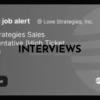Finding the right employees can be tough. It’s like searching for an apartment in NYC. It’s competitive and frustrating. The best talent feels mythical. But do not worry, entrepreneur. Building a team doesn’t have to involve smoke signals. Let’s explore the 21st-century strategies for attracting top talent.
1. Digital Gold Mines: Online Platforms & Job Boards
Your job posting needs to be online. If not, it’s as if it’s written in invisible ink. The internet is full of platforms that bridge employers with job seekers. These platforms serve as digital meeting spots where talent gathers.
- The Big Players: Use websites like
ZipRecruiter ,Indeed , orCraigslist . They’re still top players in recruitment. It’s like casting a wide net; you’ll catch something interesting. - LinkedIn – Your Networking Tool: Want to target a company to recruit talent?
LinkedIn serves as your digital spy hub. It’s useful for recruitment.- Professional Networking:
LinkedIn helps you find professionals, understand their career paths, and plant opportunities. Looking to create your dream team? This is your starting point. - Job Search Alerts: Set up alerts to track who seeks employment, what skills are needed, and discover potential candidates who aren’t actively looking.
- LinkedIn Recruiter Extractor: For deeper insights, use tools like
LinkedIn Recruiter Extractor . It helps you access company structures and personnel data.
- Professional Networking:
- Job Boards: Choose Your Weapon: General job boards like
Indeed cater to all. Niche boards serve specialized roles. They help you find specific talent. - Free Job Boards: Don’t ignore free job boards. For startups or budget-limited businesses, they offer a way to post jobs without high costs.
- Career Sites – Your Digital Billboard: Your company’s career site is vital for attracting talent. It shows your culture and opportunities. A compelling site boosts your recruitment pipeline.
- Job Search Engines: Engines like
Indeed aggregate listings. They maximize visibility for open positions.
2. Social Media: Beyond Cat Videos
Social media serves more than just vacation photos and disputes. It’s effective for recruitment if you understand how to use it.
- Broadcast Your Needs: Post job openings on
Facebook ,Twitter , andInstagram . It’s like announcing from digital rooftops in a targeted way. - Company Profiles: Before posting a job, research candidate profiles. Understanding their culture helps when crafting job descriptions.
- Employee Social Media: Encourage employees to mention your workplace online. It acts as authentic promotion for your culture.
3. Employee Referrals: Your Secret Weapon
Your employees understand your culture best. Tapping their networks reveals pre-vetted talent.
- The Power of the Ask: Asking employees for referrals can yield positive results. They often recommend respected individuals who fit well.
- Formal Referral Programs: Implement a formal program with incentives. Cash bonuses or extra days off can motivate your team.
4. Company Resources: Digging in Your Own Backyard
Your best talent might be closer than you think. Company resources are a treasure trove of potential hires.
- Company Website: The career page is vital. Ensure it’s a lively showcase of your culture and career opportunities.
- Career Sites – Crucial Reminder: Career sites reflect your employer brand and are essential for listing jobs.
- Internal Hires: Promote from within! It fills positions and shows employees there are growth paths.
- Reach Out to Former Applicants: Contact past candidates and former employees. Circumstances change, and they might be ready to return.
5. Networking and Events: Get Out of Your Office
- Industry Events: Attend events and conferences. It’s about engaging with your industry and meeting potential hires.
- College Job Fairs: Visit college job fairs to reach fresh graduates. They bring energy and new ideas.
- High School Job Fairs: Consider high school job fairs for entry-level positions. It helps plant future workforce seeds.
- Networking Events: Attending various events can lead to unexpected meetings and new opportunities.
6. Candidate Databases: Your Talent Library
Create a candidate database to avoid losing good candidates. Building this resource is like forming a reservoir of potential hires.
- Build Your Talent Pool: Start your database of candidates. Include past applicants, contacts from events, and researched individuals.
7. Recruitment Agencies & Staffing: Bringing in the Pros
Sometimes specialists are needed for recruitment. Agencies can help find niche skills or fill roles fast.
- Staffing & Temp Agencies: If you need skilled workers, agencies can provide access to pre-vetted talent.
- Larger Candidate Pool: Agencies offer a bigger pool of candidates, having already sorted potential hires.
8. Recruitment Methodologies: Strategies and Frameworks
Hiring is more than posting a job and hoping. Proven methodologies guide hiring. They ensure a systematic approach to find the right talent.
significantly improve your recruitment process and outcomes.
- The “4R modelTM” – A Holistic Approach: The Josh Bersin Company created the “4R modelTM”. It’s about recruitment and a complete talent strategy. This includes Recruit, Retain, Reskill, and Redesign. It offers a full view of talent management.
- The “Rule of Three” – Decision-Making Efficiency: The “Rule of Three” simplifies hiring. Managers must choose from the top three candidates. This focused evaluation helps avoid decision paralysis.
- Skills Gap Analysis – Hiring with Purpose: Perform a skills gap analysis before recruiting. Determine your company’s needed skills to achieve goals. This ensures you hire based on strategic needs, not just to fill vacancies.
- The 3 C’s of Hiring – Character, Competence, Chemistry: Assess candidates using competence, character, and chemistry. It’s about skills, integrity, and fitting into your team’s dynamic.
- The 5 C’s of Recruitment – Expanding the Lens: The 5 C’s build upon the 3 C’s. Character, Culture Fit, Career Direction, Competence, and Communication Skills create a detailed evaluation framework. This helps candidates understand employer expectations beyond skills.
- The 3 R’s in HR – Recruit, Reward, Retain – The Cycle of Talent: Keep the 3 R’s in mind: Recruit, Reward, Retain. Neglecting any part creates issues. It affects morale, productivity, and profit. This cycle is continuous, not isolated actions.
- Skills-Based Hiring – Focus on What Matters: Embrace skills-based hiring. Write job descriptions highlighting important skills. Structure interviews to assess those skills directly. Use assignments to simulate real work tasks. Skills matter more than experience.
- The Two-Day Rule – Speed Matters: The “Two-Day Rule” states that you should respond to candidates within two days of their application. Top candidates are in demand. Quick responses give you a competitive edge in hiring.
9. Addressing Labor Shortages: The Talent Drought – Where Did Everyone Go?
Labor shortages exist in many sectors. Finding employees feels like locating water in a desert.
- Industries in the Hot Seat: Some industries are feeling the labor squeeze. Healthcare, construction, technology, trucking, accounting, retail, food service, and teaching roles face these challenges. If hiring in these sectors, be ready for competition.
- Understanding the “Why”: Worker shortages are complex. A key factor is the labor force participation rate. Currently, it’s lower than pre-pandemic levels. A smaller share of the population actively seeks work. Knowing these macroeconomic trends aids in strategizing.
10. Specific Hiring Strategies: Tailoring Your Approach – Location, Location, Location… and Beyond
Hiring requires tailored strategies. Consider your location and the talent type you seek.
- Local Employees – Keeping it Close to Home:
- Advertise Locally – Think Hyper-Local: For local roles, focus on your community’s advertising. Utilize local newspapers, bulletin boards, and social media groups.
- Jobcentre Plus – UK Specific, But Concept Applies: In the UK, Jobcentre Plus connects employers with local job seekers. Similar services exist elsewhere; explore local resources.
- Network Locally – Community Connections: Use your local network. Join chambers of commerce and local business associations. Community events work for finding local talent.
- Small Towns – Expanding Your Horizon: Hiring in small towns requires creativity.
- Remote Employees – Location Independence: Consider remote employees. Many roles aren’t location-dependent, broadening your talent pool.
- Recruit Beyond Local Borders – Think Regionally, Nationally, Globally: Actively recruit beyond your area. Attract talent willing to relocate or work remotely.
- Promote Your Community – Sell the Lifestyle: When recruiting outside your area, emphasize community benefits. Highlight quality of life, affordability, and small-town charm to attract candidates seeking change.
11. Job Ad Optimization: SEO for Job Listings – Making Yourself Findable
Like customers find products online, job seekers need to locate your ads. SEO is vital for recruitment.
- SEO-Friendly Job Ads & Career Pages – Get Found in the Search Results: Create SEO-friendly job ads and career pages. Include relevant keywords in job titles and descriptions so listings appear in search results during candidate searches.
- Skills-Based Job Descriptions – Clarity and Keywords: Writing skills-based job descriptions clarifies needs while incorporating keywords job seekers use in searches.
12. Free Options: Budget-Friendly Hiring – Saving Those Pennies (and Dollars)
Hiring can be done without draining your funds. Numerous free or low-cost options are available, especially for startups.
- Free Job Boards – Worth Repeating: Free is Good!: Free job boards are effective, especially for entry-level or general roles.
- Social Media Advertising – Organic Reach (and Paid if You Dare): Social media advertising can be organic (free) or through paid ads (budget-depending). Even organic posts can reach a broad audience.
- Referrals – The Ultimate Free Resource: Requesting referrals costs minimal effort. This is often the most cost-effective recruitment method yielding high-quality candidates.
13. Finding Employees of a Specific Company: Targeted Talent Acquisition – The Art of Headhunting (Ethically)
Sometimes you seek a specific employee from a competitor. Here’s how to approach it ethically.
- LinkedIn – Advanced Search Wizardry:
LinkedIn offers advanced search filters. Target employees using company name, job title, location, and skills to find ideal candidates. - Job Boards – Company Name Search – Sneaky but Effective: Many job boards allow company name searches—this identifies individuals with desired experiences.
- Company Websites – “Team” or “About Us” Pages – Publicly Available Intel: Check company “Team” or “About Us” pages for employee names and roles. This provides a starting point to identify potential candidates.
- Social Media – Beyond Company Pages: Individual Profiles: Use social media platforms like
Facebook andInstagram . Look for employee mentions in their profiles, especially if companies have strong online presences. - Employee Referral Networks – Indirect Inquiries: Use your employee referral network to subtly inquire about individuals at target companies. Employees may know someone suitable.
14. Important Considerations: The Big Picture – Beyond the Resume
Hiring exceeds merely filling vacated seats. It requires strategic investments to build a long-lasting team. Keep these wider considerations in mind.
- Total Cost of Hiring – The Hidden Expenses: Evaluate total hiring costs beyond salary. Include taxes, benefits, onboarding expenses, and training cost. In places like California, these costs accumulate.
- Employee Loyalty – The Retention Factor: Employee loyalty must be earned. Competitive compensation, benefits, and wellness perks foster loyalty while reducing turnover.
- Prompt Response – Respecting Candidate Time (and Your Own): Recall the Two-Day Rule? It emphasizes speed while respecting candidates’ time and professionalism. A prompt response indicates a well-organized employer.
- “Great” Over “Experienced” – Potential vs. Pedigree: Avoid fixating solely on experience. Seek candidates with the right skills, attitude, and potential for growth. Sometimes raw talent beats experienced but stagnant individuals.
15. Employee Honesty: Trust, But Verify – Navigating the Honesty Minefield
Honesty is crucial; verifying it is wise. Use strategies to assess and encourage honesty during hiring.
- Thorough Employment Application – Setting the Stage for Transparency: Implement a detailed employment application. This gathers comprehensive information and sets honesty expectations.
- The “Answer Truthfully” Pitch – Direct and Upfront: Present candidates an “answer truthfully” pitch upfront. State the importance
- of honesty and integrity in your company culture.
- Pre-Employment Honesty Tests – A Controversial Tool, Use with Caution: Use pre-employment honesty tests. Ensure they are legally compliant and ethically sound. They serve as a tool, not a definitive answer.
- The Interview – Digging Deeper: The interview helps assess honesty. Use direct questioning and observation. Note verbal and non-verbal cues.
- Credit Checks – A Financial Snapshot (and Another Potentially Controversial Tool): Conduct credit checks with caution. Be aware of legal and ethical factors. Use them judiciously and only when job-related.
16. Work Schedule Options: Beyond the 9-to-5 Grind – Flexibility is Key
The typical 9-to-5 schedule lacks flexibility. Offering alternative work schedules can attract talent. Many individuals seek work-life balance.
- 9/80 Schedule – The Extended Weekend Option: The 9/80 schedule allows a day off every other week. Employees work longer days. It appeals to those who enjoy longer weekends.
- 4/10 Schedule – Four-Day Workweek (Almost): The 4/10 schedule has four 10-hour shifts weekly. It results in a three-day weekend. This is a perk for attracting and retaining employees.
Finding the ideal employee might seem like searching for a rare apartment. With these strategies, you have a map and a compass. Plus, a hint of humor can help you navigate the talent landscape. Good luck!





